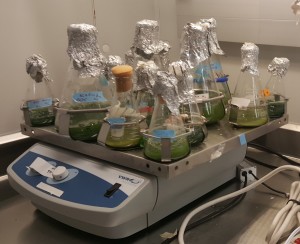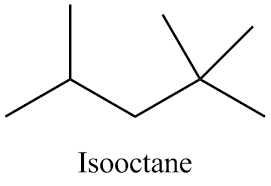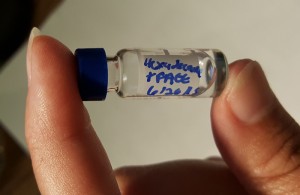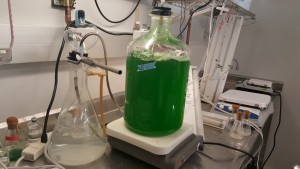I’ve heard the term “biofuel” before, and that usually conjures up images of corn fields and ethanol. I recently attended a lecture at Washington University presented by Fuzhong Zhang. The title of the workshop was quite intimidating: “Synthetic Regulatory Systems for Dynamic Metabolic Pathways.” Teachers don’t just spend our summers lazing about at the pool!

The program was actually very good and not that as complicated as the title suggested. The Zhang Group is currently working on synthetic biology to create organisms that can produce fuel. This is the next generation of biofuels, not fuels made from corn or other organic material, but made from bacteria that have been engineered to create certain products.
This technology addresses probably the biggest economic concern of using biofuels or types of energy to power cars. While sales of electric cars are on the rise, changes to infrastructure are slower. There is a gas station on every corner, but it may take longer for charging stations to be added to every neighborhood.
People will be slow to adopt new technology and the cost may be prohibitive for everyone to abandon their petrol-powered cars for ones that run on other forms of energy. That’s why the fuel engineered by bacteria may have a real advantage. If we can essentially “grow” gasoline in a lab, then we can use existing infrastructure.
To meet the increasing demands of sustainable transportation energy, we aim to engineer microbes to produce advanced biofuels that could be readily used in current engines. One of the biggest challenges is to biosynthesize non-natural molecules that have structures exactly the same or highly similar to the fuels currently derived from petroleum. We are engineering enzymes and constructing novel metabolic pathways to produce these compounds.
I went to the workshop hoping to take away some ideas in current biology topics to share with my students. The lecture focused on how bacteria can be manipulated to make carbon compounds that can be used as fuel. The bacteria they started with was Mycopasma genitalium. (At this point, I quietly pulled out my phone to check wikipedia, curious as to the origin of this bacteria.) This bacterium lives in the urinary and genital tracks of humans and is considered a sexually transmitted pathogen. In 2007, Craig Venter created the first synthetic genome based on M. genitalium. Though the lecture I participated in didn’t go into the original study, I can only assume the the mycoplasm was used because it was an organism that had the smallest known genome.

In order to create a bacteria that could make gasoline, Gayle Bentley describe the process like a treasure hunt, outlining the steps needed to get the desired results.
1. Know what you want to make, in this case, isooctane (gasoline)
2. Find the enzymes that can perform the reactions. There are naturally occurring enzymes that can convert long chain fatty acids into alkanes.
3. Clone microbe that has these enzymes

4. Measure production and target intermediates
5. Optimize system
Admittedly, I lost focus when there was too much information on the chemical pathways and the system optimization, but I was fascinated by the process of turning regular old bacteria like E. coli into something that could make gasoline. We spend a lot of time on enzymes in AP Biology, and this is another story to add to my tool box.
We were able to tour the lab and see how the equipment is being used to isolated and optimize the products. Pictured below is cyanobacteria that is also being looked at because it can photosynthesize, is easy to grow in a lab (or in a lake) and can reduce carbon in the atmosphere.

This article from Local Fox 2 News does a great job at further explaining the research occurring at Washington University on synthetic biology.

